Three Smart Tips for Selecting the Right Pressure Control Valve
As simple as it may sound, there are few things more important than selecting the right pressure control valve.
Pressure valves are designed to hold back, or resist pressure, and each valve rated with a Maximum Allowable Working Pressure (MAWP). If you pick a valve that’s not right for the job at hand you put yourself at risk of damaging the property – or even hurting yourself.
Thankfully, selecting the correct valve is actually much easier than it may seem, and we’ll help you to find out which pressure valve you need. Here are a few tips you can use to find the right pressure control valve for your job.
Know the Type of Pressure Control Valve You Need
No matter what project you plan to do, you need to know what type of valve is required to do it.
There are a vast number of pressure valves out there to choose from. To narrow the search down, it would help you to know the flow control type you need, the function the pressure valve will handle, and the operation it’s supposed to perform.
For example, some valves allow you to control or regulate flow (Shutoff & Needle Valves); while others are used in back- flow & water hammer prevention (Check & Stop-Check Valves). Others can be used for safety and pressure relieving purposes (Relief Valves); and still others are used for in-service calibration and pressure measurement (Instrument Valves).
Know What Materials You Need out of Your Valve
Valves are constructed out of different materials, and you’ll want to know what materials are suitable for your project.
The media that flows through the pressure valve – be it gas (high purity, CO 2 , mixed gas, or flammable O 2 or H 2 ), liquid (water, oil, acids, food, chemicals), or plasma can affect the valve and reduce its performance if the wrong material is used.
There are a number of corrosive resistant valves made to handle harmful or caustic flow media, and other valves made from more standard materials for non-corrosive media, so make sure to choose wisely. Please contact us directly to ask our engineering team the best valve material to use for your application.
Know Your Valve Size
Finally, knowing your pressure valve size is important. Of course, if you don’t get the right size, you’ll most likely get a valve that doesn’t fit. However, there is more to it than that.
The size of your valve also correlates to the flow rate and capacity requirements of your piping system. For example, if a valve is too small it could throttle the flow of the media, making it harder to carry out the task.
An incorrect pressure valve size could also cause damage to the overall system, meaning you’ll have to shell out more money for repairs.
Knowing your valve size could help you avoid these problems and get your system working properly.
The Latest in Industry Standards
Now that you know what to look for in your pressure control valve, you need to know where to go in order to get the pressure valves you need at a price that works for you. Don’t worry: we’ve got you covered.
For many years, CPV Manufacturing has been a leader in quality manufacturing, and we make sure to give only the best to our customers. We offer a vast array of valves for you to choose from, as well as a long list of quality fittings.
Our products are made to industrial standards and work to the standards of aerospace, shipbuilding, oil and gas, chlorine, petrochemical, and pharmaceutical sectors.
If you have any questions about who we are or what we do, please don’t hesitate to reach out. We’d be more than happy to answer any questions you may have. We look forward to helping support and provide assistance on your next project!

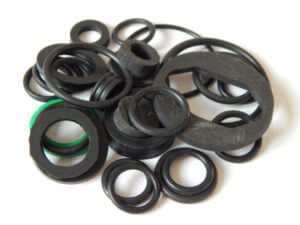
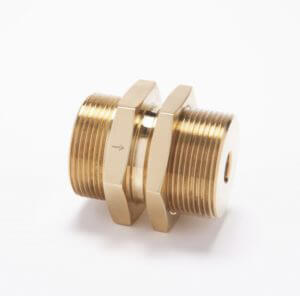 Check valves, which control the flow of fluid (gas or liquid) in one direction, are opened by the velocity of the forward-moving fluid. Depending on the type of check valve, they close when the flow slows, stops, or reverses, preventing the fluid from flowing in the reverse direction.
Check valves, which control the flow of fluid (gas or liquid) in one direction, are opened by the velocity of the forward-moving fluid. Depending on the type of check valve, they close when the flow slows, stops, or reverses, preventing the fluid from flowing in the reverse direction. 
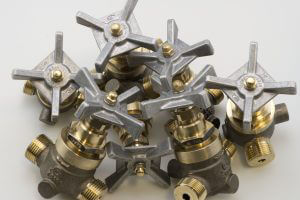 eristic, or the relationship between the valve stem travel and the flow through the valve, typically should be linear (when plotted on a chart). The inherent flow characteristic (which comes from the manufacturer) usually changes once put into operation. Things such as drops in pressure choked flow (flashing and cavitation), and location of the valve within the system will have an impact on the flow characteristic.
eristic, or the relationship between the valve stem travel and the flow through the valve, typically should be linear (when plotted on a chart). The inherent flow characteristic (which comes from the manufacturer) usually changes once put into operation. Things such as drops in pressure choked flow (flashing and cavitation), and location of the valve within the system will have an impact on the flow characteristic.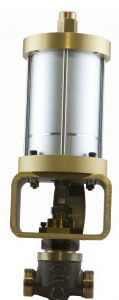
 Once the oil has been extracted, typically the water will be removed from the hydrocarbons, and natural gas liquids will be separated from the fluid stream. Sometimes sour gas, raw petroleum containing hydrogen sulfide, is present. Due to its highly corrosive, flammable, and toxic nature, special handling is required including the use of corrosion-resistant valve materials.
Once the oil has been extracted, typically the water will be removed from the hydrocarbons, and natural gas liquids will be separated from the fluid stream. Sometimes sour gas, raw petroleum containing hydrogen sulfide, is present. Due to its highly corrosive, flammable, and toxic nature, special handling is required including the use of corrosion-resistant valve materials.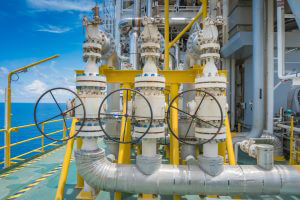 The stem is connected to the disc, which is what opens and closes the valve. The valve stem has to be able to withstand the force needed to move the disc, so it has to be very strong, but also resistant to corrosion and erosion. Metal alloys are usually a good choice for the stem.
The stem is connected to the disc, which is what opens and closes the valve. The valve stem has to be able to withstand the force needed to move the disc, so it has to be very strong, but also resistant to corrosion and erosion. Metal alloys are usually a good choice for the stem.